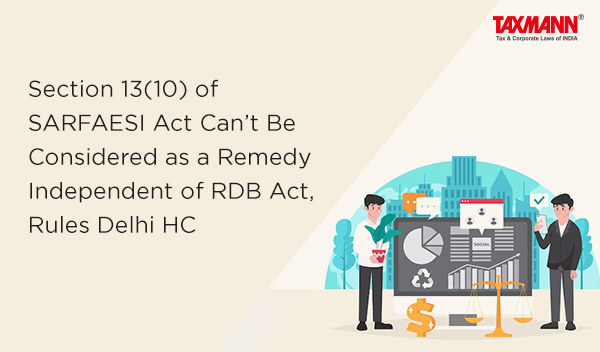Section 13(10) of SARFAESI Act Can’t Be Considered as a Remedy Independent of RDB Act, Rules Delhi HC
- Blog|News|FEMA & Banking|
- 2 Min Read
- By Taxmann
- |
- Last Updated on 28 November, 2023

Case Details: 156 taxmann.com 635 (Delhi)[01-11-2023]
Judiciary and Counsel Details
-
- Vibhu Bakhru & Amit Mahajan, JJ.
- Sanjeev Singh & Ms Ridhi Pahuja, Advs. for the Petitioner.
-
Vivek Goyal, Mimansak Bhardwaj, Gokul Sharma, Shivam Singh & Ms Aneeta Goyal, Advs. for the Respondent.
Facts of the Case
In the instant case, the question that arose before the court was whether the Debt Recovery Tribunal (DRT) can entertain a claim for an amount less than Rs.10 lakhs under the SARFAESI Act.
The IDFC First Bank (hereinafter referred to as “Petitioner”) has approached the court, challenging the rejection of its application under Section 13(10) SARFAESI Act by the Debts Recovery Tribunal (DRT) on the ground that it lacks its pecuniary jurisdiction.
The outstanding amount in question was approximately Rs. 6,92,551.63, with interest, and the DRT argued that the RDB Act didn’t apply when the debt due to bank is less than Rs. 20,00,000.
The petitioner submitted that section 13(10) of the SARFAESI Act expressly enables a secured creditor to file an application for a recovery of the balance amount from a borrower if its claims are not fully satisfied from the sale proceeds of secured assets. According to the petitioner, Section 13(10) of the SARFAESI Act is a separate code, independent of the RDB Act, for the recovery of amounts due to the secured creditors that remain outstanding after the proceeds of the secured assets are appropriated.
The petitioner further argued that Section 13(10) of the SARFAESI Act provided an independent remedy and should be considered separately from the provisions of the RDB Act. Further, the petitioner contended that as a result the contended that the pecuniary limit as set in Section 1(4) of the RDB Act was not applicable to Section 13(10) SARFAESI Act applications.
High Court Held
The court dismissed the petition of the petitioner on the following grounds:
(a) The SARFAESI Act does not specify which DRT would have jurisdiction to handle Section 13(10) applications.
(b) There are no valid reasons to disregard the pecuniary jurisdiction limits of the DRT under the RDB Act.
The Court further emphasized that when the DRT is explicitly granted jurisdiction, it should exercise it regardless of the threshold specified under the RDB Act.
The Court concluded that an application under Section 13(10) of the SARFAESI Act, for all practical purposes, was an Original Application under Section 19 of the RDB Act. Therefore, the remedy under the SARFAESI Act could not be considered independent of the RDB Act, and the court dismissed IDFC’s petition.
Disclaimer: The content/information published on the website is only for general information of the user and shall not be construed as legal advice. While the Taxmann has exercised reasonable efforts to ensure the veracity of information/content published, Taxmann shall be under no liability in any manner whatsoever for incorrect information, if any.

Taxmann Publications has a dedicated in-house Research & Editorial Team. This team consists of a team of Chartered Accountants, Company Secretaries, and Lawyers. This team works under the guidance and supervision of editor-in-chief Mr Rakesh Bhargava.
The Research and Editorial Team is responsible for developing reliable and accurate content for the readers. The team follows the six-sigma approach to achieve the benchmark of zero error in its publications and research platforms. The team ensures that the following publication guidelines are thoroughly followed while developing the content:
- The statutory material is obtained only from the authorized and reliable sources
- All the latest developments in the judicial and legislative fields are covered
- Prepare the analytical write-ups on current, controversial, and important issues to help the readers to understand the concept and its implications
- Every content published by Taxmann is complete, accurate and lucid
- All evidence-based statements are supported with proper reference to Section, Circular No., Notification No. or citations
- The golden rules of grammar, style and consistency are thoroughly followed
- Font and size that’s easy to read and remain consistent across all imprint and digital publications are applied





